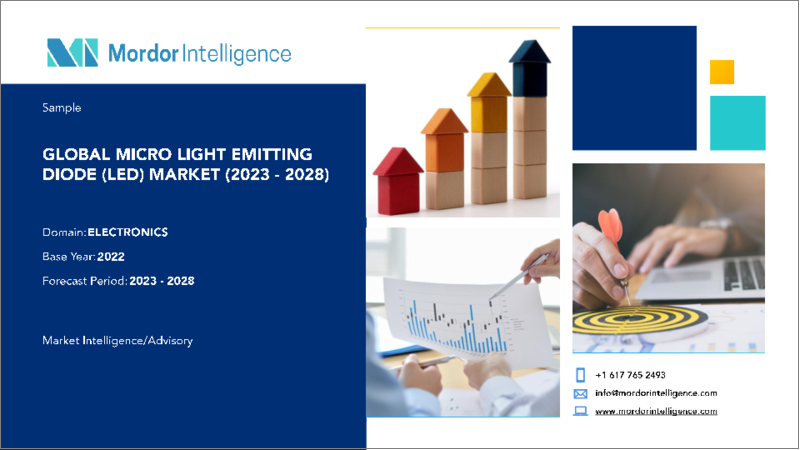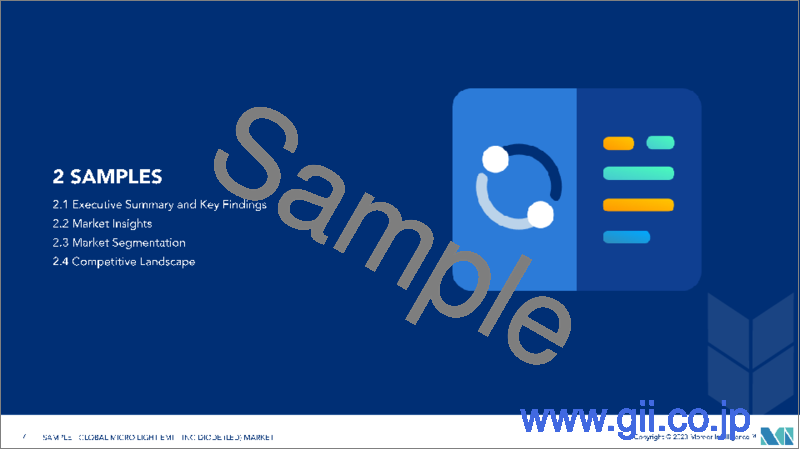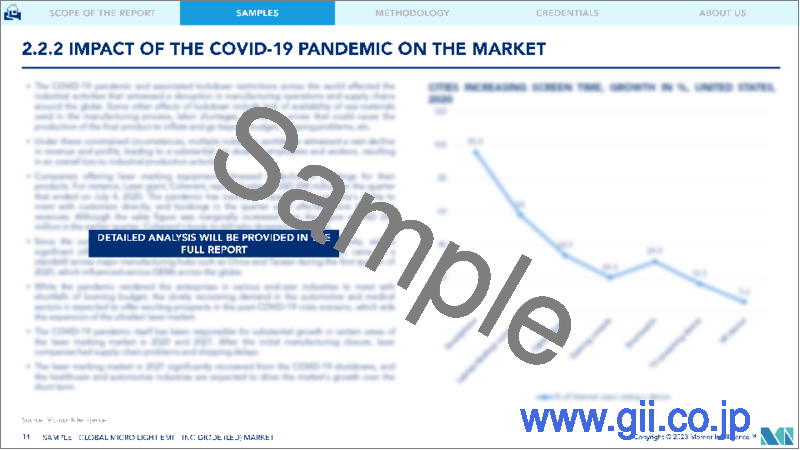|
|
市場調査レポート
商品コード
1197589
マイクロ発光ダイオード(LED)市場- 成長、動向、予測(2023年-2028年)Micro Light Emitting Diode (LED) Market - Growth, Trends, and Forecasts (2023 - 2028) |
||||||
|
● お客様のご希望に応じて、既存データの加工や未掲載情報(例:国別セグメント)の追加などの対応が可能です。 詳細はお問い合わせください。 |
|||||||
| マイクロ発光ダイオード(LED)市場- 成長、動向、予測(2023年-2028年) |
|
出版日: 2023年01月23日
発行: Mordor Intelligence
ページ情報: 英文 120 Pages
納期: 2~3営業日
|
- 全表示
- 概要
- 目次
マイクロLED市場は、予測期間中に51.1%のCAGRで推移すると予想されています。
MEMS技術の急速な普及と相まって、民生技術の成長が市場の成長をさらに後押ししています。
主なハイライト
- 現在の市場では、液晶ディスプレイ(LCD)と有機発光ダイオード(OLED)の2つがフラットパネルディスプレイ技術として主流となっています。しかし、最近では、LCDのダイナミックレンジを大幅に向上させたり、太陽光を読み取ることができる発光ディスプレイとして、マイクロLEDや無機ミニLEDが台頭してきました。
- マイクロLEDは、液晶ディスプレイよりも発光が単純で、個別に制御することができます。そのため、画質(応答速度、コントラスト)が大幅に向上し、液晶ディスプレイのようなフィルターがないため、高効率なディスプレイが実現できます。有機ELは、有機発光材料でできた微小なサブピクセルを利用します。マイクロLEDは、有機ELに似た構造で、無機ELを用いたものです。有機ELに比べ、高効率で明るく、耐久性が高く(寿命が長い)、色域が広いという特徴があります。
- ミニLEDやマイクロLEDスクリーンは、LCDやOLEDディスプレイに比べて、薄型でエネルギー効率に優れているなど、いくつかの利点があります。そのため、複数の企業が最新技術を採用する可能性のある新しいデバイスを開発しています。Apple社は、iPhone、iPad、スマートウォッチのディスプレイ用途にマイクロLED技術を取り入れることに大きな関心を示しました。
- ウェアラブル製品には、小型・軽量、低消費電力、耐環境性などが要求されます。したがって、進歩するマイクロLED技術は、スマートなウェアラブル製品の開発にとって不可欠なものとなっています。マイクロLEDは、スマートウォッチやメガネの革新的なアプリケーションのための次世代ディスプレイとして期待されています。2020年12月、コンカは初のマイクロLED Watch「APHAEA Watch」を発表しました。画素ピッチ0.12mmの2インチマイクロLEDディスプレイを採用し、マイクロLEDチップは30umの大きさです。
- さらに、高速通信と小型モバイルコンピューティングプラットフォームの急速な進歩により、従来のフラットパネルディスプレイを超えた、より深い人間とデジタルとのインタラクションに対する強い要求がエスカレートしています。また、ARやVRなどの技術により、次世代インタラクティブディスプレイの需要が高まっており、様々な産業分野での応用が進んでいます。このような動向は、ARとVRアプリケーションのためのマイクロLEDの採用を促進すると予想されます。
マイクロLEDの市場動向
AR/VRが大きな市場シェアを占めるようになる
- 仮想現実と拡張現実の技術は、没入型体験を受け入れ、ユーザーとデバイス間の相互作用を促進することで、ユーザーが電子機器やガジェットとやりとりする方法を再定義しています。このような動向は、他の技術の中でも特に高度なディスプレイ技術に対する需要を増大させる。
- マイクロLEDは、消費電力を抑えながら高い輝度とコントラストを確保する先進のディスプレイ技術です。これらの特徴は、最高の視覚体験を提供する拡張現実(AR)および仮想現実(VR)アプリケーションに特に関連しています。アプリケーションの増加に伴い、複数の企業が協力して先進的な技術を開発し、デバイスに統合して、ユーザーの体験を向上させることに刺激を与えています。
- 2021年10月、中国の電子企業TCLは、フルカラーの透明マイクロLEDディスプレイを搭載した全く新しいThunderbird Smart Glasses Pioneer Editionを発表しました。このメガネにはカメラも内蔵されており、ユーザーはフレームの側面をクリックするだけで写真を撮ることができます。このメガネは、透明なディスプレイとTCLが3年前から採用している導波路技術により、通常のメガネのように見えます。また、このメガネは拡張現実にも対応している可能性があり、メガネを通してユーザーの視界にデジタル情報のレイヤーを追加することができます。
- さらに、2021年12月には、ハイエンドの拡張現実(AR)メガネ用のマイクロLEDディスプレイの技術会社であるMICLEDI Microdisplaysが、300mm CMOS製造プラットフォーム上に構築した業界初のマイクロLEDアレイフォーARのデモンストレーションを行いました。300mm製品戦略による高度な製造精度、性能、コスト効率により、MICLEDIはARメガネメーカーに選ばれるディスプレイパートナーとして認知されています。
- また、2021年9月、Xiaomiは、OLEDと比較してシンプルな構造を持ちながら、より高いピクセル密度と長寿命を実現するモノクロマイクロLEDシステムを搭載したXiaomi Smart Glassesというスマートグラスを発表しています。Xiaomiによると、マイクロLEDはディスプレイをよりコンパクトにし、スクリーンとの統合を容易にするとのことです。
北米が最大のシェアに
- スマートフォンの普及が進んでいることが、この地域でマイクロLEDを採用する最大の要因の1つと考えられています。近年、米国ではスマートフォンの販売台数が一貫して伸びています。Zippiaによると、米国では約2億9,415万人がスマートフォンを所有しており、これは同国の総人口の約89%に相当します。
- また、同地域ではスマートウォッチの普及が進んでいることから、マイクロLED市場の採用が拡大すると予想されています。グーグルやアップルなどの企業は、同地域で拡大するこれらのデバイスの機会を活用するため、米国で新しいスマートウォッチを発売する予定です。例えば、2022年10月、グーグルは同社初のスマートウォッチを発売し、オンラインとニューヨークの実店舗で販売する予定です。
- 米国特許商標庁は、Apple Inc.に対して、フレキシブルでローリング可能なディスプレイの特許を付与しました。同社は現在、2つの独立したハウジングがロールアウトし、中央にフラットなディスプレイが現れることを特徴とするデバイスの開発を検討しています。また、この特許は、デバイスが剛体ディスプレイとローラブルスクリーンの両方を搭載する可能性があることを示しています。
- さらに、2022年5月、米国のARスマートグラスメーカーであるVuzikは、Atomistic SASとの契約を発表しました。この戦略的合意により、Vuzixは同社のスマートグラスにマイクロLEDレンズを使用する独占ライセンスを取得し、Atomistic SASはVuzixのAR製品のカスタムバックプレートの設計を支援することになります。このような新興国市場の開拓は、予測期間中の研究市場の成長を促進します。
マイクロLED市場の競合他社分析
マイクロ発光ダイオード(LED)市場は、競争が激しいです。イノベーションと持続可能な製品の増加により、多くの企業が世界市場での地位を維持するために、新規契約の確保と新規市場の開拓によって市場での存在感を高めています。主な発展をいくつか紹介します。
2022年10月、アビセナはNanosysからmicroLED製造施設と関連エンジニアリングチームを買収したと発表しました。この買収により、アビセナは、マルチTbpsの並列インターコネクトに最適化された高速GaNマイクロLEDの開発・製造能力を大幅に強化することになります。
2022年3月、グーグルは、拡張現実および複合現実デバイスに使用されるディスプレイ用の小型発光ダイオードを開発するMicroLEDベースのスタートアップ、ラクシウムの買収を発表しました。この買収により、グーグルはARディスプレイを作ることができるようになります。
その他の特典。
- エクセル形式の市場予測(ME)シート
- アナリストによる3ヶ月間のサポート
目次
第1章 イントロダクション
- 調査の前提条件と市場の定義
- 調査対象範囲
第2章 調査手法
第3章 エグゼクティブサマリー
第4章 マーケットインサイト
- 市場概要
- 産業バリューチェーン分析
- 産業の魅力-ポーターのファイブフォース分析
- 新規参入業者の脅威
- 買い手の交渉力
- 供給企業の交渉力
- 代替品の脅威
- 競争企業間の敵対関係
第5章 市場力学
- 市場促進要因
- MEMS技術の出現
- コンシューマーエレクトロニクスの成長
- 市場抑制要因
- 物質移動がMicro Ledの商業化のボトルネックになる可能性
- サプライチェーンにおける複雑さ
第6章 市場セグメンテーション
- アプリケーション別
- ディスプレイ
- スマートウォッチ
- 近接型デバイス(AR、VR)
- テレビ
- スマートフォン・タブレット
- モニター・ノートPC
- ヘッドアップディスプレイ
- デジタルサイネージ
- 照明
- ディスプレイ
- エンドユーザー別
- コンシューマーエレクトロニクス
- 自動車
- 航空宇宙・防衛
- その他のエンドユーザー
- 地域別一覧
- 北米
- 欧州
- アジア太平洋地域
- 世界のその他の地域
第7章 競合情勢
- 企業プロファイル
- Innolux Corporation
- Sony Corporation
- LG Display Co Ltd
- Aledia SA
- Epistar Corporation
- Optovate Limited
- Rohinni LLC
- Samsung Electronics Co. Ltd
- JBD Inc.
- Plessey Semiconductors Limited
- Ostendo Technologies Inc.
- VueReal Inc.
- Allos Semiconductors
第8章 投資分析
第9章 市場機会と将来動向
The micro LED market is expected to register a CAGR of 51.1% during the forecast period. The rising growth of consumer technology coupled with an emergency of MEMS technology is further boosting the growth of the market studied.
Key Highlights
- In the current market, liquid crystal displays (LCDs) and organic light-emitting diode (OLED) displays are the two dominant flat-panel display technologies. However, micro-LEDs (μLEDs) and inorganic mini-LEDs (mLEDs) have recently emerged by significantly enhancing LCDs' dynamic range or as sunlight-readable emissive displays.
- A micro-LED is considerably simpler than an LCD, as they emit light and can be controlled individually. This results in displays that offer significantly better image quality (response time, contrast) and are highly efficient, too, as there are no filters in LCDs. OLEDs utilize tiny sub-pixels made from organic emissive materials. Micro-LEDs are somewhat similar but with an inorganic LED structure. Compared to OLEDs, micro-LEDs are poised to be much more efficient and brighter, more durable (higher lifetime), and with a higher color gamut.
- Mini-LED and micro-LED screens have several advantages over LCD and OLED displays, such as being thinner and more energy-efficient. As a result, several companies are developing new devices that may use the latest technologies. Apple showed significant interest in incorporating micro-LED technology in its iPhone, iPad, and smartwatch display applications.
- The requirements of wearable products include small size, lightweight, low power consumption, and environmental resistance. The progressing micro-LED technologies, thus, become critical for the development of smart wearables. Micro-LED is poised to be the next-generation display for innovative applications for smartwatches and glasses. In December 2020, Konka introduced the first micro-LED Watch, the APHAEA Watch. It uses a 2-inch micro-LED display with a pixel pitch of 0.12 mm, and the micro-LED chips are 30 um in size.
- Further, rapid advances in high-speed communication and miniature mobile computing platforms escalated a strong demand for deeper human-digital interactions beyond traditional flat panel displays. AR and VR technologies are driving the growth of next-generation interactive displays with increased applications across various industries. Such trends are expected to boost micro-LED adoption for AR and VR applications.
Micro LED Market Trends
AR/VR to Account for Significant Market Share
- Virtual Reality and augmented reality technologies have redefined the way users interact with electronics and gadgets by embracing an immersive experience and promoting interaction between the user and the device. Such trends augment the demand for advanced display technologies, amongst other technologies.
- Micro-LED is an advanced display technology that ensures high brightness and contrast while keeping power consumption low. These features are particularly relevant for augmented reality (AR) and virtual reality (VR) applications to deliver the best visual experience. The increased number of applications stimulates several companies to collaborate to develop and integrate advanced technologies in their devices and enhance the user's experience.
- In October 2021, Chinese electronics company TCL unveiled its brand-new Thunderbird Smart Glasses Pioneer Edition, equipped with a full-color transparent micro-LED display. The glasses also have an inbuilt camera allowing users to take pictures with a click on the side of the frame. The glasses look like regular specs due to their transparent displays and the waveguide technology that TCL has been using for three years. The glasses may also have augmented reality support, which means they can add layers of digital information to the user's vision through the glasses.
- Further, in December 2021, MICLEDI Microdisplays, a technology company in micro-LED displays for high-end augmented reality (AR) glasses, demonstrated the industry's first micro-LED arrays-for-AR built on a 300mm CMOS manufacturing platform. The advanced manufacturing precision, performance, and cost-efficiency offered by the 300mm product strategy distinguish MICLEDI as a display partner of choice for AR glasses manufacturers.
- Also, in September 2021, Xiaomi introduced a pair of smart glasses called Xiaomi Smart Glasses, equipped with a monochrome micro-LED system that provides higher pixel density and a longer lifespan while having a simpler structure compared to OLED. According to Xiaomi, micro-LED allows for a more compact display and easier screen integration.
North America to Account for Largest Share
- The increasing penetration of smartphones is considered one of the biggest contributors toward adopting micro LED in the region. In recent years, the United States witnessed consistent growth in smartphone sales. According to Zippia, around 294.15 million people in the United States own a smartphone, which is about 89% of the country's total population.
- The increasing penetration of smartwatches in the region is also expected to augment the adoption of the micro LED market. Companies, such as Google and Apple are planning to launch a new smartwatch in the United States to leverage the growing opportunities of these devices in the region. For instance, in October 2022, Google launched its first smartwatch, which will be available online and in its physical store in New York City.
- The United States Patent and Trademark Office has granted a patent for Apple Inc. for a flexible and rolling display. The company is now looking at developing a device featuring two separate housings which roll out to reveal a flat display in the center. The patent also indicates that the devices could feature both a rigid display and a rollable screen.
- Further, in May 2022, Vuzik, a United States-based manufacturer of AR smart glasses, announced an agreement with Atomistic SAS. The strategic agreement provides Vuzix with an exclusive license to use microLED lenses for its smart glasses, and Atomistic SAS will assist Vuzix in designing custom backplates for its AR products. Such developments fuel the studied market's growth over the forecast period.
Micro LED Market Competitor Analysis
The Micro Light Emitting Diode (LED) Market is highly competitive. With increased innovations and sustainable products, many companies are increasing their market presence by securing new contracts and tapping new markets to maintain their position in the global market. Some of the key developments are:
In October 2022, Avicena announced the acquisition of a microLED fabrication facility and associated engineering team from Nanosys. The transaction will significantly enhance Avicena's capabilities in developing and manufacturing high-speed GaN microLEDs optimized for parallel multi-Tbps interconnects.
In March 2022, Google announced the acquisition of Raxium, a MicroLED-based start-up that develops tiny light-emitting diodes for displays used in augmented and mixed-reality devices. The acquisition will help Google make AR displays.
Additional Benefits:
- The market estimate (ME) sheet in Excel format
- 3 months of analyst support
TABLE OF CONTENTS
1 INTRODUCTION
- 1.1 Study Assumptions and Market Definition
- 1.2 Scope of the Study
2 RESEARCH METHODOLOGY
3 EXECUTIVE SUMMARY
4 MARKET INSIGHTS
- 4.1 Market Overview
- 4.2 Industry Value Chain Analysis
- 4.3 Industry Attractiveness - Porter's Five Forces Analysis
- 4.3.1 Threat of New Entrants
- 4.3.2 Bargaining Power of Buyers
- 4.3.3 Bargaining Power of Suppliers
- 4.3.4 Threat of Substitute Products
- 4.3.5 Intensity of Competitive Rivalry
5 MARKET DYNAMICS
- 5.1 Market Drivers
- 5.1.1 Emergence of MEMS Technology
- 5.1.2 Growth of Consumer Electronics
- 5.2 Market Restraints
- 5.2.1 Mass Transfer to be a Bottleneck for Commercialization of Micro Led
- 5.2.2 Complexities Through the Supply Chain
6 MARKET SEGMENTATION
- 6.1 By Application
- 6.1.1 Display
- 6.1.1.1 Smartwatch
- 6.1.1.2 Near-to-eye Devices (AR and VR)
- 6.1.1.3 Television
- 6.1.1.4 Smartphone and Tablet
- 6.1.1.5 Monitor and Laptop
- 6.1.1.6 Head-up Display
- 6.1.1.7 Digital Signage
- 6.1.2 Lighting
- 6.1.1 Display
- 6.2 By End User
- 6.2.1 Consumer Electronics
- 6.2.2 Automotive
- 6.2.3 Aerospace and Defense
- 6.2.4 Other End Users
- 6.3 By Geography
- 6.3.1 North America
- 6.3.2 Europe
- 6.3.3 Asia-Pacific
- 6.3.4 Rest of the World
7 COMPETITIVE LANDSCAPE
- 7.1 Company Profiles
- 7.1.1 Innolux Corporation
- 7.1.2 Sony Corporation
- 7.1.3 LG Display Co Ltd
- 7.1.4 Aledia SA
- 7.1.5 Epistar Corporation
- 7.1.6 Optovate Limited
- 7.1.7 Rohinni LLC
- 7.1.8 Samsung Electronics Co. Ltd
- 7.1.9 JBD Inc.
- 7.1.10 Plessey Semiconductors Limited
- 7.1.11 Ostendo Technologies Inc.
- 7.1.12 VueReal Inc.
- 7.1.13 Allos Semiconductors




